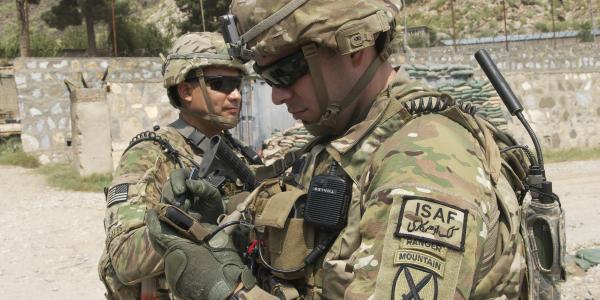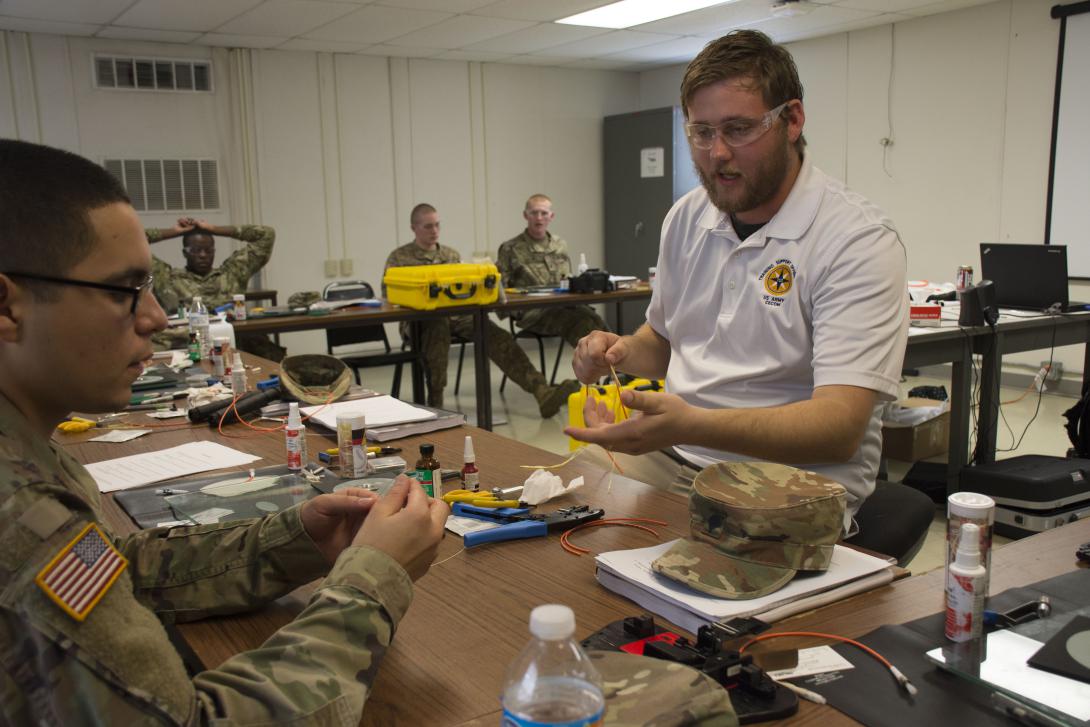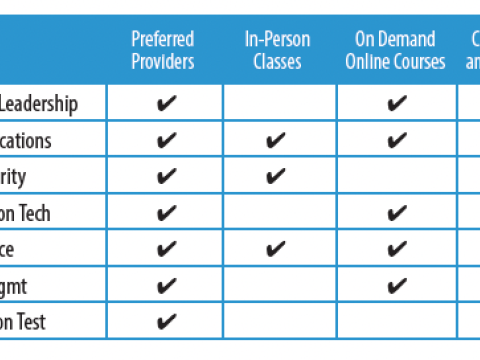The Army Trains Its Sights On Network Ownership
The U.S. Army is strengthening network operations by giving soldiers true ownership responsibilities, according to service officials. A new training effort teaches soldiers the elements of network operation at their home bases before deployment, reducing the need for contractors to provide support in the field. It empowers soldiers to operate networks more efficiently as they assume greater responsibility for the task at the unit level.
The Home Station Training Initiative, referred to as HSTI, is not just another “train as you fight” approach applied to network operators. It centralizes training for network operations, readiness and fielding, and it aims to transform the Army’s customer culture—one where someone else provides and maintains the network—to an ownership culture.
“We’ve had 15 years of combat in theater where units didn’t take their network with them—they received theater-provided equipment,” says Brig. Gen. Karl H. Gingrich, USA, assistant program executive officer, Command, Control and Communications–Tactical (PEO C3T). “When you’re given something, allowed to use it for a specified period of time and required to turn it in before you go back to home station, that breeds a customer mentality. You don’t take care of it; you rely on an FSR [field service representative]. You don’t have the time or capacity, or really the willingness, because you don’t own the system. What [HSTI] does … is push ownership back to the user.”
The initiative, which began last year, taps expertise scattered across Army installations and coordinates it with base commanders and communicators. The diversity of systems serving soldiers during deployment has decentralized training for network operations, readiness and fielding. HSTI will coordinate this training before deployment to allow soldiers to operate the network effectively, Army officials say.
The approach could lead to a decline in the large number of trouble tickets linked to training-related deficits. Gen. Gingrich reports that 95 percent of the tickets submitted in combat training center (CTC) rotations have been tied to soldier- and user-level issues, and 75 percent of those have been related to training.
Years of continuous combat have led soldiers to depend on contracted logistics support, which has become unsustainable, says Larry Muzzelo, deputy to the commanding general, U.S. Army Communications–Electronics Command (CECOM). Despite the drawdown in Southwest Asia, units still are deploying at a high operations tempo.
Many bases have multiple avenues for command, control, communications, computers, intelligence, surveillance and reconnaissance (C4ISR) training, but units are not always aware of them, Muzzelo states. Training providers may not be synchronized with each other, which hinders the ability to meet specific unit training requirements.
The reliance on FSR support has led to FSRs taking over work originally tasked to soldiers, Gen. Gingrich explains. HSTI aims to eliminate that.
The initiative strives to build proficiency by providing soldiers the necessary training repetitions using Army information systems. “It’s about repetitions,” Gen. Gingrich declares. Repetitions increase unit readiness. Without HSTI, the high tempo of deployed units leads to competition between mission operations and network training, and soldiers are hard-pressed to learn important details of network operations.
The effort also determines training challenges and priorities as it expands its reach. HSTI analyzes trouble tickets submitted during CTC rotations, and this data is used to conceptualize trends, identify skill gaps and pinpoint training or equipping needs for specific units, Muzzelo explains. “Through this, we have reinvigorated unit training with home-station resources, through which we’re working to achieve C4ISR system proficiency for both signal soldiers and general purpose users,” he says.
Officials are seeking to expand the data pool beyond CTC rotations by including trouble-ticket data from home-station events, which would help in both tailoring and updating training, Muzzelo says. But planners want to be able to incorporate still more types of data into training support packages more quickly. “We don’t have the data I think we really need, and we don’t have the means to capture that data today. That’s another thing we need to work on,” he states.
Data gathered from CTC rotations indicates that most issues involving training shortfalls are resolvable at the unit level with increased unit training at home stations. Such training could provide units data indicating what challenges they might expect in the field.
Both units and their commanders are integral parts of putting HSTI in motion. It is not top-down, driven by CECOM, officials say. Its experts on site can access trouble-ticket data to help commanders identify where their problems reside.
HSTI ensures that commanders know what local training aids they have at their disposal, Gen. Gingrich offers. The initiative also is energizing the institutional training base by establishing strong lines of communication between CECOM and the signal and cyber centers of excellence at Fort Gordon, Georgia, he says. This ensures those centers have the latest training support packages coming out of New Equipment Training and New Equipment Fielding.
Gen. Gingrich emphasizes that HSTI supplements and even enhances unit-level training. “We never want to replace sergeants’ time,” he declares. “We never want to replace first-line leaders helping to train their soldiers. What we want to do is to make sure that units are aware and have access to training venues where they get experts who can help provide some of that training, some of the repetitions. That helps reduce the requirements on the units to generate these training events.”
HSTI produces other benefits as well. The effort helps standardize training across formations, minimizing costs, because each one has many resident capabilities that can be applied to units seeking training. CECOM, for example, offers low-cost mobile training teams to bring needed expertise to soldiers at their bases. The initiative also compels information sharing. As soldiers move up in rank, they impart their knowledge below, Gen. Gingrich states.
Ultimately, the hope is to decrease network complexity, which will reduce the repetitions needed to stay current on training. This will take time, the general notes, and the Army will need to maintain its extensive training until complexity is eliminated through acquisition.
The ongoing onslaught of new information technologies can tax training efforts, but officials are working to ensure that HSTI keeps up with the march of innovation. Although the Army is not fielding new network technologies as quickly as it wants to, it must not become lax in anticipating training needs, Gen. Gingrich says. “We’re going to have to keep our eye on the equipment sets that are being fielded to certain locations, make sure that we anticipate them and make sure that … we get the training representatives at those locations ... to build that capability,” he emphasizes. This way, units will have a ready source for training as soon as gear can be deployed, and HSTI can tie that training to each unit’s equipment.
With many new networking technologies coming from the commercial world, industry will play an important role in both training and inserting capability. Gen. Gingrich warrants that industry must pay more attention to Army technology needs early in the acquisition process, saying, “Engineer out every bit of complexity at the front end prior to giving it to soldiers. And [businesses] need to do that using soldiers, not engineers.”
Input from soldiers is vital because they are better judges of how technology will work in the field than engineers, the general continues. For example, Gen. Gingrich offers that today’s soldiers think in terms of applications on their cellphones, and that approach could be the template for a universal interface. Industry must think like soldiers to reduce the training burden on units. “They download an application on their phone, and they don’t then go to a training or technical manual and read 50 to 100 pages on how to use it. They just start hitting buttons and put it into operation,” he observes.
Industry also needs to do a better job on the front end of software development, the general continues. Issues include pushing software to the field and automating updates so that soldiers are out of that loop. “We need a control mechanism, such as a configuration control board, in place that controls and governs software updates,” Gen. Gingrich says. Also, the Army needs to automate information assurance vulnerability alert (IAVA) updates as much as possible to ensure they are applied quickly.
Early feedback about HSTI is positive, Gen. Gingrich reports. One brigade combat team completing HSTI before going to a CTC rotation generated considerably fewer trouble tickets. Other units from the same geographic location that completed the rotation experienced a 22 percent drop in trouble tickets. Both data and anecdotal evidence suggest that forces in the field like and benefit from the initiative, he says. Forces that have used HSTI have better reception, staging, onward movement and integration as they start to enter the CTC and bring the network online, Muzzelo states.
Above all, units do not “fight the network,” he says. The network operates more effectively to support the commander’s scheme of maneuver, but Muzzelo emphasizes that these preliminary findings need further examination.






Comments